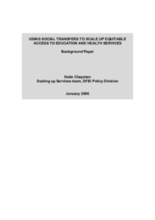Slow progress towards achieving the Millenium Development Goals (MDGs) has rekindled interest in social transfers as a means to reduce poverty and accelerate progress. The Commission for Africa, for example, has called for a major scaling up in social assistance to vulnerable children. Social transfers are increasingly recognised as an important component of an overall care package for children affected by AIDS. The World Bank is scaling up its support to social transfers as a key policy response to inequities in health and education opportunities for the poorest and socially excluded groups. UNESCO promotes targeted social transfers as a way of changing the balance of incentives for girls to attend school. WHO has recently launched a Commission on Social Determinants of Health, which includes a review of the potential of social transfer programmes to improve health.
This paper provides background analysis to support a DFID Policy Division Briefing Note on Using Social Transfers to Improve Human Development. This work complements DFID’s Practice Paper Social Transfers and Chronic Poverty (2005). It also forms one part of DFID’s workstream on promoting equitable access to health and education services. Policies that promote poor people’s access to health and education services are critical to making best use of scaled up resources. Scaling up poor people’s access will require a combination of health and education system investments along with investments outside those sectors. These may include demand side approaches that promote the use of available services, as well as increasing service coverage. This paper focuses on the impact of one form of demand-side policy option - social transfers, particularly cash transfers and vouchers - on access to health and education services by the extreme poor. It also touches upon the broader contribution that social transfers make to human development outcomes.
©DFID

